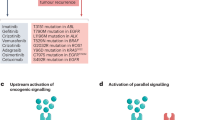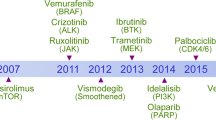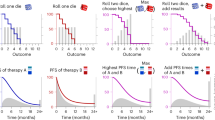Key Points
-
The use of drug combinations to circumvent tumour resistance is a well-established principle of cancer therapy.
-
There are now a large number of molecular targeted anticancer drugs available to test in clinical trials. Establishing strategies to choose from the almost limitless possibilities and focus on prioritizing the most promising combinations is therefore paramount.
-
The variables to consider in the clinical development of combinations of targeted agents include: mechanisms of action and resistance of single agents and their mechanisms of interaction; rational and robust preclinical demonstration of additivity or preferably synergy for a combination; and a strategy for testing proof-of-principle in the clinical setting that reflects the preclinical models that showed activity.
-
Combination strategies for targeted agents that have been proposed to date can be divided into three broad categories: combinations to maximize the inhibition of a specific target; to maximize inhibition of a pathway by targeting multiple components; and to expand inhibition of multiple cellular mechanisms.
-
In general, strategies to rationally evaluate the activity of combination regimens should take into consideration both knowledge of the single agents — including mechanisms of action, clinical pharmacology, toxicity profile and antitumour activity — and non-clinical evaluation of the combination.
-
To maximize translatability of preclinical study results, the proposed regimen should be tested in a variety of tumour models at clinically achievable doses/exposures, and, if possible, the target status and molecular context of the tumour models that correspond to treatment outcomes should be defined.
-
Our current ability to move beyond empirical selection and evaluation of molecularly targeted agents and their combinations is often limited by inadequate knowledge of the biology and molecular features of specific tumours; inadequate understanding of the mechanisms of action/resistance for individual agents and their combinations, as well as inadequate tools to measure and compare treatment effects in laboratory models that can be predictably used in clinical development.
-
To overcome these barriers, future studies should continue to focus on several essential tasks: a systematic approach to non-clinical studies of targeted agents and combinations; correlative studies in both preclinical and clinical settings; and the development of reliable assays or tests for clinical use for either patient selection and/or measuring biological/pharmacodynamic effects.
Abstract
The rapid emergence of hundreds of new agents that modulate an ever-growing list of cancer-specific molecular targets offers tremendous hope for cancer patients. However, evaluating targeted agents individually, in combination with standard treatments, and in combination with other targeted agents presents significant development challenges. Because the number of possible drug combinations is essentially limitless, a strategy for determining the most promising combinations and prioritizing their evaluation is crucial. Here, we consider the crucial elements of a development strategy for targeted-agent combinations. Issues that pose challenges to the rational preclinical and clinical evaluation of such combinations will be described, and possible approaches to overcoming these challenges will be discussed.
This is a preview of subscription content, access via your institution
Access options
Subscribe to this journal
Receive 12 print issues and online access
$209.00 per year
only $17.42 per issue
Buy this article
- Purchase on Springer Link
- Instant access to full article PDF
Prices may be subject to local taxes which are calculated during checkout


Similar content being viewed by others
References
Heinrich, M. C. et al. Kinase mutations and imatinib response in patients with metastatic gastrointestinal stromal tumor. J. Clin. Oncol. 21, 4342–4349 (2003).
Druker, B. J. et al. Efficacy and safety of a specific inhibitor of the BCR-ABL tyrosine kinase in chronic myeloid leukemia. N. Engl. J. Med. 344, 1031–1037 (2001).
Mass, R. D. et al. Evaluation of clinical outcomes according to HER2 detection by fluorescence in situ hybridization in women with metastatic breast cancer treated with trastuzumab. Clin. Breast Cancer 6, 240–246 (2005).
Slamon, D. J. et al. Use of chemotherapy plus a monoclonal antibody against HER2 for metastatic breast cancer that overexpresses HER2. N. Engl. J. Med. 344, 783–792 (2001).
Hurwitz, H. et al. Bevacizumab plus irinotecan, fluorouracil, and leucovorin for metastatic colorectal cancer. N. Engl. J. Med. 350, 2335–2342 (2004).
Sandler, A. B. et al. Randomized phase II/III Trial of paclitaxel (P) plus carboplatin (C) with or without bevacizumab (NSC # 704865) in patients with advanced non-squamous non-small cell lung cancer (NSCLC): An Eastern Cooperative Oncology Group (ECOG) Trial- E4599. J. Clin. Oncol. 24, A4 (2005).
Bonner, J. A. et al. Radiotherapy plus cetuximab for squamous-cell carcinoma of the head and neck. N. Engl. J. Med. 354, 567–578 (2006).
Herbst, R. S. et al. Gefitinib in combination with paclitaxel and carboplatin in advanced non-small-cell lung cancer: a phase III trial — INTACT 2. J. Clin. Oncol. 22, 785–794 (2004).
Giaccone, G. et al. Gefitinib in combination with gemcitabine and cisplatin in advanced non-small-cell lung cancer: a phase III trial — INTACT 1. J. Clin. Oncol. 22, 777–784 (2004).
Herbst, R. S. et al. TRIBUTE: a phase III trial of erlotinib hydrochloride (OSI-774) combined with carboplatin and paclitaxel chemotherapy in advanced non-small-cell lung cancer. J. Clin. Oncol. 23, 5892–5899 (2005).
Burtness, B., Goldwasser, M. A., Flood, W., Mattar, B. & Forastiere, A. A. Phase III randomized trial of cisplatin plus placebo compared with cisplatin plus cetuximab in metastatic/recurrent head and neck cancer: an Eastern Cooperative Oncology Group study. J. Clin. Oncol. 23, 8646–8654 (2005).
Hirte, H. et al. A phase III randomized trial of BAY 12-9566 (tanomastat) as maintenance therapy in patients with advanced ovarian cancer responsive to primary surgery and paclitaxel/platinum containing chemotherapy: A National Cancer Institute of Canada Clinical Trials Group Study. Gynecol. Oncol. 24 Jan 2006 [epub ahead of print].
Moore, M. J. et al. Comparison of gemcitabine versus the matrix metalloproteinase inhibitor BAY 12–9566 in patients with advanced or metastatic adenocarcinoma of the pancreas: a phase III trial of the National Cancer Institute of Canada Clinical Trials Group. J. Clin. Oncol. 21, 3296–3302 (2003).
Shepherd, F. A. et al. Prospective, randomized, double-blind, placebo-controlled trial of marimastat after response to first-line chemotherapy in patients with small-cell lung cancer: a trial of the National Cancer Institute of Canada-Clinical Trials Group and the European Organization for Research and Treatment of Cancer. J. Clin. Oncol. 20, 4434–4439 (2002).
Sparano, J. A. et al. Randomized phase III trial of marimastat versus placebo in patients with metastatic breast cancer who have responding or stable disease after first-line chemotherapy: Eastern Cooperative Oncology Group trial E2196. J. Clin. Oncol. 22, 4683–4690 (2004).
Kirkwood, J. M. et al. Long-term survival results of a randomized multinational phase 3 trial of dacarbazine (DTIC) with or without Bcl-2 antisense (oblimersen sodium) in patients (pts) with advanced malignant melanoma (MM). J. Clin. Oncol. 24, A7506 (2005).
De Soto, J. A., Bowen, D., Davis, J. H., Southerland, W. M. & Hawkins, M. Jr . Sequence- and time-dependent antagonism between raloxifene and methotrexate in human breast cancer cells. AntiCancer Res. 22, 1007–1009 (2002).
Osborne, C. K., Kitten, L. & Arteaga, C. L. Antagonism of chemotherapy-induced cytotoxicity for human breast cancer cells by antiestrogens. J. Clin. Oncol. 7, 710–717 (1989).
Albain, K. et al. Adjuvant chemohormonal therapy for primary breast cancer should be sequential instead of concurrent: initial results from intergroup trial 0100 (SWOG-8814). Proc. Am. Soc. Clin. Oncol. 21, A143 (2002).
Friedman, H. S. et al. Enhancement of nitrosourea activity in medulloblastoma and glioblastoma multiforme. J. Natl. Cancer Inst. 84, 1926–1931 (1992).
Friedman, H. S. et al. Phase I trial of O6-benzylguanine for patients undergoing surgery for malignant glioma. J. Clin. Oncol. 16, 3570–3575 (1998).
Rhines, L. D. et al. O6-benzylguanine potentiates the antitumor effect of locally delivered carmustine against an intracranial rat glioma. Cancer Res. 60, 6307–6310 (2000).
Jagtap, P. & Szabo, C. Poly(ADP-ribose) polymerase and the therapeutic effects of its inhibitors. Nature Rev. Drug Discov. 4, 421–440 (2005).
Farmer, H. et al. Targeting the DNA repair defect in BRCA mutant cells as a therapeutic strategy. Nature 434, 917–921 (2005).
Haince, J. F., Rouleau, M., Hendzel, M. J., Masson, J. Y. & Poirier, G. G. Targeting poly(ADP-ribosyl)ation: a promising approach in cancer therapy. Trends Mol. Med. 11, 456–463 (2005).
Posadas, E. M. et al. Clinical synergism from combinatorial VEGF signal transduction inhibition in patients with advanced solid tumors — early results from a Phase I study of sorafenib (BAY 43–9006) and bevacizumab. Eur. J. Cancer 3 (Suppl.), A1450 (2005).
Saltz, L. B. et al. Randomized Phase II trial of cetuximab/bevacizumab/irinotecan (CBI) versus cetuximab/bevacizumab (CB) in irinotecan-refractory colorectal cancer. Proc. Am. Soc. Clin. Oncol. 24, A3508 (2005).
Moulder, S. L. & Arteaga, C. L. A Phase I/II trial of trastuzumab and gefitinib in patients with Metastatic Breast Cancer that overexpresses HER2/neu (ErbB-2). Clin. Breast Cancer 4, 142–145 (2003).
Hainsworth, J. D. et al. Treatment of metastatic renal cell carcinoma with a combination of bevacizumab and erlotinib. J. Clin. Oncol. 23, 7889–7896 (2005).
Herbst, R. S. et al. Phase I/II trial evaluating the anti-vascular endothelial growth factor monoclonal antibody bevacizumab in combination with the HER-1/epidermal growth factor receptor tyrosine kinase inhibitor erlotinib for patients with recurrent non-small-cell lung cancer. J. Clin. Oncol. 23, 2544–2555 (2005).
Genentech, Inc. Genentech announces preliminary results from randomized Phase II trial of Avastin and Tarceva in kidney cancer. Press Release October[online], (2005).
Normanno, N. et al. Cooperative inhibitory effect of ZD1839 (Iressa) in combination with trastuzumab (Herceptin) on human breast cancer cell growth. Ann. Oncol. 13, 65–72 (2002).
Warburton, C. et al. Treatment of HER-2/neu overexpressing breast cancer xenograft models with trastuzumab (Herceptin) and gefitinib (ZD1839): drug combination effects on tumor growth, HER-2/neu and epidermal growth factor receptor expression, and viable hypoxic cell fraction. Clin. Cancer Res. 10, 2512–2524 (2004).
Baselga, J. et al. Phase II and tumor pharmacodynamic study of gefitinib in patients with advanced breast cancer. J. Clin. Oncol. 23, 5323–5333 (2005).
Abd El-Rehim, D. M. et al. Expression and co-expression of the members of the epidermal growth factor receptor (EGFR) family in invasive breast carcinoma. Br. J. Cancer 91, 1532–1542 (2004).
Bhargava, R. et al. EGFR gene amplification in breast cancer: correlation with epidermal growth factor receptor mRNA and protein expression and HER-2 status and absence of EGFR-activating mutations. Mod. Pathol. 18, 1027–1033 (2005).
Bianchi, S. et al. ErbB-receptors expression and survival in breast carcinoma: a 15-year follow-up study. J. Cell Physiol. 206, 702–708 (2006).
Kelland, L. R. Of mice and men: values and liabilities of the athymic nude mouse model in anticancer drug development. Eur. J. Cancer 40, 827–836 (2004).
Shinn, C., Larsen, D. & Suarez, J. R. Flavopiridol sensitivity of chronic lymphocytic leukemia (CLL) cells in vitro varies based upon species specific drug protein binding. Blood 96, 294b (2000).
Gitler, M. S., Monks, A. & Sausville, E. A. Preclinical models for defining efficacy of drug combinations: mapping the road to the clinic. Mol. Cancer Ther. 2, 929–932 (2003).
Reynolds, C. P. & Maurer, B. J. Evaluating response to antineoplastic drug combinations in tissue culture models. Methods Mol. Med. 110, 173–183 (2005).
Tallarida, R. J. Drug synergism: its detection and applications. J. Pharmacol. Exp. Ther. 298, 865–872 (2001).
Teicher, B. A. Assays for in vitro and in vivo synergy. Methods Mol. Med. 85, 297–321 (2003).
Chou, T. C. Drug combinations: from laboratory to practice. J. Lab. Clin. Med. 132, 6–8 (1998).
Houghton, P. J. et al. Antitumor activity of temozolomide combined with irinotecan is partly independent of O6-methylguanine-DNA methyltrans-ferase and mismatch repair phenotypes in xenograft models. Clin. Cancer Res. 6, 4110–4118 (2000).
Meco, D. et al. Effective combination of ET-743 and doxorubicin in sarcoma: preclinical studies. Cancer Chemother. Pharmacol. 52, 131–138 (2003).
Tan, M., Fang, H. B., Tian, G. L. & Houghton, P. J. Experimental design and sample size determination for testing synergism in drug combination studies based on uniform measures. Stat. Med. 22, 2091–2100 (2003).
Engelholm, S. A. et al. Genetic instability of cell lines derived from a single human small cell carcinoma of the lung. Eur. J. Cancer Clin. Oncol. 21, 815–824 (1985).
Ferguson, P. J. & Cheng, Y. C. Phenotypic instability of drug sensitivity in a human colon carcinoma cell line. Cancer Res. 49, 1148–1153 (1989).
Smith, A., van Haaften-Day, C. & Russell, P. Sequential cytogenetic studies in an ovarian cancer cell line. Cancer Genet. Cytogenet. 38, 13–24 (1989).
Johnson, J. I. et al. Relationships between drug activity in NCI preclinical in vitro and in vivo models and early clinical trials. Br. J. Cancer 84, 1424–1431 (2001).
Voskoglou-Nomikos, T., Pater, J. L. & Seymour, L. Clinical predictive value of the in vitro cell line, human xenograft, and mouse allograft preclinical cancer models. Clin. Cancer Res. 9, 4227–4239 (2003).
Ciardiello, F. et al. Antitumor activity of ZD6474, a vascular endothelial growth factor receptor tyrosine kinase inhibitor, in human cancer cells with acquired resistance to antiepidermal growth factor receptor therapy. Clin. Cancer Res. 10, 784–793 (2004).
Jones, H. E. et al. Insulin-like growth factor-I receptor signalling and acquired resistance to gefitinib (ZD1839; Iressa) in human breast and prostate cancer cells. Endocr. Relat. Cancer 11, 793–814 (2004).
Solit, D. B. et al. Pulsatile administration of the epidermal growth factor receptor inhibitor gefitinib is significantly more effective than continuous dosing for sensitizing tumors to paclitaxel. Clin. Cancer Res. 11, 1983–1989 (2005).
Kaelin, W. G., Jr . The concept of synthetic lethality in the context of anticancer therapy. Nature Rev. Cancer 5, 689–698 (2005).
Borisy, A. A. et al. Systematic discovery of multicomponent therapeutics. Proc. Natl Acad. Sci. USA 100, 7977–7982 (2003).
Moore, M. J. et al. Erlotinib plus gemcitabine compared to gemcitabine alone in patients with advanced pancreatic cancer. A phase III trial of the National Cancer Institute of Canada Clinical Trials Group [NCIC-CTG]. J. Clin. Oncol. ASCO Ann. Mtg Proc. 23, A1 (2005).
Miller, K. et al. First-line bevacizumab and paclitaxel in patients with locally recurrent or metastatic breast cancer: a randomized, phase III trial coordinated by the Eastern Cooperative Oncology Group (E2100) Eur. J. Cancer Suppl. ECCO 13 Abstract Book 3, 77 A275 (2005).
Miller, K. D. et al. Randomized phase III trial of capecit-abine compared with bevacizumab plus capecitabine in patients with previously treated metastatic breast cancer. J. Clin. Oncol. 23, 792–799 (2005).
Tabernero, J. et al. Combined anti-EGFR blockade: A Phase I pharmacokinetic and molecular pharmaco-dynamic study of cetuximab (Erbitux) and gefitinib (Iressa) in patients with advanced colorectal, head and neck and non-small cell lung cancer expressing the EGFR. Clin. Cancer Res. 11 8990s Abs. A107 (2005).
Milton, D. T. et al. Phase I/II trial of gefitinib and RAD001 (Everolimus) in patients (pts) with advanced non-small cell lung cancer (NSCLC). Proc. Am. Soc. Clin. Oncol. 24, A7104 (2005).
Reardon, D. A. et al. Phase 1 trial of gefitinib plus sirolimus in adults with recurrent malignant glioma. Clin. Cancer Res. 12, 860–868 (2006).
Britten, C. D. et al. Targeting ErbB receptor interactions: A phase I trial of trastuzumab and erlotinib in metastatic HER2+ breast cancer. J. Clin. Oncol. 22, A3045 (2004).
Acknowledgements
The authors wish to acknowledge the contributions of M. Christian, S. Ansher and L. Grochow to development of the concepts described in this manuscript.
Author information
Authors and Affiliations
Corresponding author
Ethics declarations
Competing interests
The authors declare no competing financial interests.
Related links
Related links
DATABASES
Rights and permissions
About this article
Cite this article
Dancey, J., Chen, H. Strategies for optimizing combinations of molecularly targeted anticancer agents. Nat Rev Drug Discov 5, 649–659 (2006). https://doi.org/10.1038/nrd2089
Issue Date:
DOI: https://doi.org/10.1038/nrd2089
This article is cited by
-
A new function for drug combination dose finding trials
Scientific Reports (2024)
-
Predicting heterogeneity in clone-specific therapeutic vulnerabilities using single-cell transcriptomic signatures
Genome Medicine (2021)
-
A chemogenomic approach to identify personalized therapy for patients with relapse or refractory acute myeloid leukemia: results of a prospective feasibility study
Blood Cancer Journal (2020)
-
A cancer drug atlas enables synergistic targeting of independent drug vulnerabilities
Nature Communications (2020)
-
The ACTIVE study protocol: apatinib or placebo plus gefitinib as first-line treatment for patients with EGFR-mutant advanced non-small cell lung cancer (CTONG1706)
Cancer Communications (2019)



